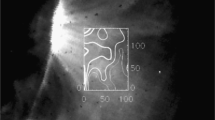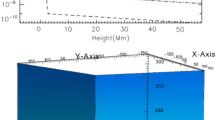Abstract
The coronal magnetic field cannot be directly observed, but, in principle, it can be reconstructed from the comparatively well observed photospheric magnetic field. A popular approach uses a nonlinear force-free model. Non-magnetic forces at the photosphere are significant, meaning the photospheric data are inconsistent with the force-free model, and this causes problems with the modeling (De Rosa et al., Astrophys. J. 696, 1780, 2009). In this paper we present a numerical implementation of the Grad–Rubin method for reconstructing the coronal magnetic field using a magnetostatic model. This model includes a pressure force and a non-zero magnetic Lorentz force. We demonstrate our implementation on a simple analytic test case and obtain the speed and numerical error scaling as a function of the grid size.







Similar content being viewed by others
Notes
A boundary value problem is said to be well-posed if it has a unique solution which depends continuously on the boundary conditions.
We note that this solution is a special case of the linear force-free solution due to Barbosa (1978), and is obtained by setting α=0 in that solution.
These metrics are chosen because they show the largest discrepancy between the numerical and the analytic fields.
References
Aly, J.J., Amari, T.: 2007, Geophys. Astrophys. Fluid Dyn. 101, 249.
Alissandrakis, C.E.: 1981, Astron. Astrophys. 100, 197.
Amari, T., Boulmezaoud, T.Z., Mikic, Z.: 1999, Astron. Astrophys. 350, 1051.
Amari, T., Boulmezaoud, T.Z., Aly, J.J.: 2006, Astron. Astrophys. 446, 691.
Amari, T., Boulbe, C., Boulmezaoud, T.Z.: 2009, SIAM J. Sci. Comput. 31, 3217.
Barbosa, D.D.: 1978, Solar Phys. 56, 55.
Bineau, M.: 1972, Commun. Pure Appl. Math. 25, 77.
Boulmezaoud, T.Z., Amari, T.: 2000, Z. Angew. Math. Phys. 51, 942.
Chandra, R., Menon, R., Dagum, L., Kohr, D., Maydan, D., McDonald, J.: 2001, Parallel Programming in OpenMP, Morgan Kaufmann, San Francisco, 1.
De Rosa, M.L., Schrijver, C.J., Barnes, G., Leka, K.D., Lites, B.W., Aschwanden, M.J., et al.: 2009, Astrophys. J. 696, 1780.
Fuhrmann, M., Seehafer, N., Valori, G.: 2007, Astron. Astrophys. 476, 349.
Gary, G.A.: 2001, Solar Phys. 203, 71.
Grad, H., Rubin, H.: 1958, In: Proc. 2nd Int. Conf. Peaceful Uses of Atomic Energy 31, 190.
Hyder, C.L.: 1964, Astrophys. J. 140, 817.
Jackson, J.D.: 1998, Classical Electrodynamics, 3rd edn. Wiley, New York, 180.
Kaiser, R., Neudert, M., von Wahl, W.: 2000, Commun. Math. Phys. 211, 111.
Landi Degl’Innocenti, E., Landolfi, M.: 2004, Polarization in Spectral Lines, Kluwer Academic, Dordrecht, 625.
Lin, H., Kuhn, J.R., Coulter, R.: 2004, Astrophys. J. Lett. 613, L177.
Metcalf, T.R., Jiao, L., McClymont, A.N., Canfield, R.C., Uitenbroek, H.: 1995, Astrophys. J. 439, 474.
Morse, P.M., Feshbach, H.: 1953, Methods of Theoretical Physics, Part Two, McGraw-Hill, New York, 1252.
Nakagawa, Y., Raadu, M.A.: 1972, Solar Phys. 25, 127.
Poularikas, A.D.: 1996, In: Poularikas, A.D. (ed.) The Transform and Applications Handbook, CRC Press, Florida, 227.
Press, W.H., Teukolsky, S.A., Vetterling, W.T., Flannery, B.P.: 1992, Numerical Recipes in FORTRAN. The Art of Scientific Computing, 2nd edn. Cambridge University Press, Cambridge, 181.
Priest, E.R.: 1984, Solar Magnetohydrodynamics, Reidel, Dordrecht, 117.
Reiman, A., Greenside, H.: 1986, Comput. Phys. Commun. 43, 157.
Rudenko, G.V.: 2001, Solar Phys. 198, 279.
Sakurai, T.: 1989, Space Sci. Rev. 51, 11.
Schrijver, C.J., De Rosa, M.L., Metcalf, T.R., Barnes, G., Lites, B., Tarbell, T., et al.: 2008, Astrophys. J. 675, 1637.
Schrijver, C.J., De Rosa, M.L., Metcalf, T.R., Liu, Y., McTiernan, J., Régnier, S., Valori, G., Wheatland, M.S., Wiegelmann, T.: 2006, Solar Phys. 235, 161.
Seehafer, N.: 1978, Solar Phys. 58, 215.
Sturrock, P.A.: 1994, Plasma Physics, an Introduction to the Theory of Astrophysical, Geophysical and Laboratory Plasmas, Cambridge University Press, Cambridge, 206.
Wiegelmann, T., Neukirch, T.: 2006, Astron. Astrophys. 457, 1053.
Wiegelmann, T., Neukirch, T., Ruan, P., Inhester, B.: 2007, Astron. Astrophys. 475, 701.
Wiegelmann, T.: 2008, J. Geophys. Res. A 113, 3.
Wiegelmann, T., Inhester, B., Sakurai, T.: 2006, Solar Phys. 233, 215.
Wiegelmann, T., Inhester, B.: 2003, Solar Phys. 214, 287.
Wiegelmann, T.: 1998, Phys. Scripta T 74, 77.
Wheatland, M.S.: 2006, Solar Phys. 238, 29.
Wheatland, M.S.: 2007, Solar Phys. 245, 251.
White, S.M., Kundu, M.R.: 1997, Solar Phys. 174, 31.
Zikanov, O.: 2010, Essential Computational Fluid Dynamics, Wiley, New Jersey, 66.
Acknowledgements
S.A. Gilchrist acknowledges the support of an Australian Postgraduate Research Award.
Author information
Authors and Affiliations
Corresponding author
Appendices
Appendix A
A potential field B 0 satisfying
and the boundary conditions at z=0
is used to initiate the Grad–Rubin iteration. The appropriate field with periodic side boundary conditions is given in Equations (24)–(26) in the text. For the choice of closed side boundaries the appropriate choice is


and
where k m =πm/L, k n =πn/L, \(k^{2} = k_{m}^{2}+k_{n}^{2}\), and where the coefficients c mn are given by
Equations (49)–(52) may be evaluated on a grid with N 3 points in ∼ N 3log(N) operations using fast sine and cosine transforms (Poularikas 1996).
Appendix B
This appendix presents the solution for the current-carrying component of the test field, B c , with closed top and side boundary conditions. The magnetic field may be calculated from a vector potential A in the Coulomb gauge (∇⋅A=0) using ∇×A=B c . The vector potential satisfies the vector Poisson equation (Jackson 1998):
The boundary conditions for B c on the six plane boundaries are
where \(\hat {\mathbf {n}}\) is the unit vector normal to the boundary. The corresponding boundary conditions for the vector potential in the Coulomb gauge are (Amari, Boulmezaoud, and Mikic 1999):
and
where A t denotes the component of A transverse to the boundary, and ∂ n A denotes the normal derivative.
The vector potential A satisfying the boundary conditions Equations (55) – (56) can be written as a Fourier series:


and
where k m =πm/L, k n =πn/L, and k p =πm/L. In the following, we solve the Poisson equation to find an expression for a mnp . The process is demonstrated for the A x component, but the approach is similar for the other components.
Substituting Equation (57) into the Poisson equation (Equation (53)) gives
where \(k^{2} = k_{m}^{2}+k_{n}^{2}+k_{p}^{2}\).
Applying the standard orthogonality relations (where δ mn is the Kronecker delta):


and
yields
Similar expressions apply for the other two coefficients:
and
The magnetic field is obtained by evaluating B c =∇×A. The components of B c are


and
The solution given by Equations (67)–(69) may be computed on a grid with N 3 points in ∼ N 3log(N) operations using a combination of fast sine and cosine transforms.
Rights and permissions
About this article
Cite this article
Gilchrist, S.A., Wheatland, M.S. A Magnetostatic Grad–Rubin Code for Coronal Magnetic Field Extrapolations. Sol Phys 282, 283–302 (2013). https://doi.org/10.1007/s11207-012-0144-0
Received:
Accepted:
Published:
Issue Date:
DOI: https://doi.org/10.1007/s11207-012-0144-0




